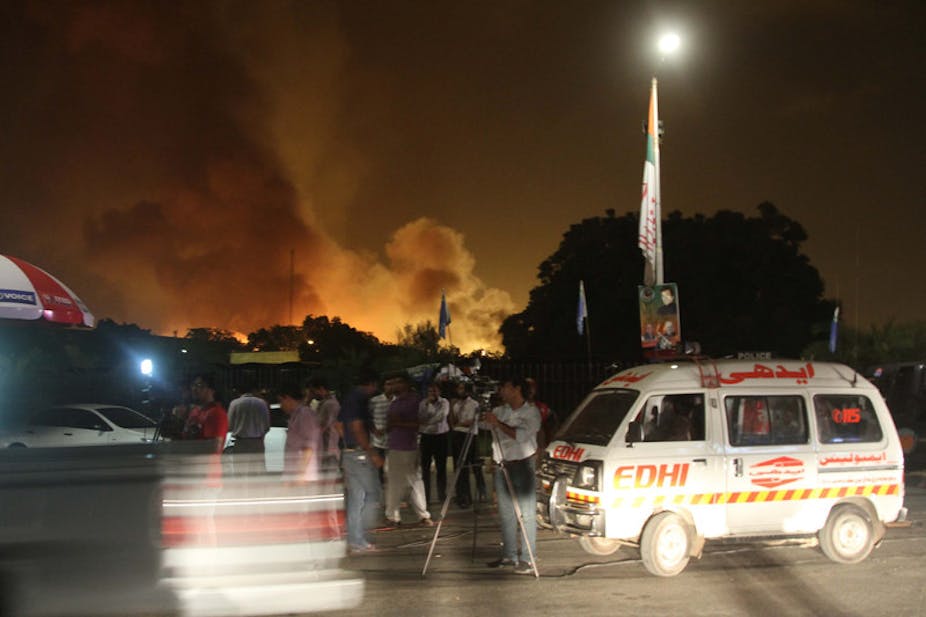Only recently, the Pakistani Taliban (TTP) was expected to fall apart: violent rivalries had split the insurgency in two, peace talks with the government had collapsed, and military jets had hit hide-outs in the tribal belt. In 2011-2012, 61% of all attacks in Pakistan were carried out by the TTP and affiliated outfits, so their imminent demise was to be a major success for the Pakistani government.
But on Sunday June 8, a cleverly executed attack on Karachi Airport was carried out. After several hours, the violence was brought to an end when all ten militants were killed, with the loss of 26 other lives. But then, as the airport was returning to service two nights later, more gunmen on motorbikes opened fire on an ASF academy at the airport, although there were no casualties.
The TTP quickly declared it a successful “joint operation” with the Islamic Movement of Uzbekistan (IMU).
The timing of this spectacular operation is not surprising: when insurgent groups split, the remaining leadership often seek to reassert authority through new levels of audacity or brutality. Last weekend’s attack certainly fits this profile. Karachi Airport is the largest international airport in Pakistan, acting as a powerful hub and gateway. Most international airlines and cargo planes use it as their main destination.
This was directly acknowledged by TTP spokesman Shahidullah Shahid, who reported to Reuters, “They will kill innocent people by their bombs and we will hit their nerve-centres in major cities.”
And the TTP have staged spectacular and strategically-minded acts of terror before. In 2011, they attacked the Mehran naval base, destroying two US-made Orion aircraft, and killing ten in the 17-hour siege; in 2009 they carried out a raid on a mosque near Pakistan’s military headquarters in Rawalpindi, which left 23 dead. In 2013, another daring jailbreak occurred in Dera Ismali Khan, resulting in 35 “high value” militants escaping (along with 240 other prisoners). What is significant about the Karachi airport attack is that it targeted the symbolic, cultural and physical infrastructure of Pakistan’s modern globalised cosmopolitan elite.
Terror in public
Although some wealthy businessmen have been kidnapped by the Taliban, most of the rich have managed to insulate themselves from its violence. Indeed, while “spectacular” violence hits the headlines, the majority of violence, casualties, and injuries are among the civilian poor.
A report by the Pakistan Peace Institute reveals that last year in the Khyber-Pashtunwakha alone 476 attacks were carried out by the TTP and associated groups, leaving 572 civilians dead (along with 115 security personnel) and injured another 1,529 (including 216 security personnel).
And the incidents at Karachi airport pale into insignificance next to the litany of violence the report contains: TTP attacks claimed casualties at schools, market areas, music shops, Eid prayer congregations, barber shops, sufi shrines, and political rallies. Consequently, many Pakistanis have started avoiding restaurants, theatres, religious festivals and other public spaces for fear of becoming victims.
These locations are not random targets, nor are they merely instrumental in military terms. Convinced that humanity can be perfected, the TTP is using violence to rid politics and the public sphere of the “unperfectable”: women, homosexuals, those of other religions and sects. Their aim is to confine politics to a restricted group of people (“righteous males”), a limited range of activities (excluding fine arts and public expressions of merriment), and a severely constrained public space.
The attack on the airport was a reminder to Pakistan’s elite that they are not exempt from this order. While the violence and associated loss of life is appalling enough, one of its more insidious consequences is the constriction it places on public spaces, and the choking of political and social life. Unwittingly or not, the TTP recognise that to reorder public life, you must transform social and public spaces – and that violence can effect that transformation.
Looking at the gender dimension to TTP terrorism highlights this connection. In their worldview the Islamic world (characterised by “appropriate” and “moral” segregated gender order) pitted against an imperialist, amoral and decadent West in a simplistic, righteous struggle. To create this moral order, TTP started violently targeting female folk singers and dancers in 2007, while also attacking Sufi shrines where women congregate. Continuing a long running campaign, in the Swat district in 2013, 473 schools were defaced or destroyed; the resultant decline in enrolment and attendance is hardly surprising. The TTP denies women access to politics and public life by publicly humiliating them, destroying their spaces, and murdering them for alleged infractions of moral decency, leaving their tortured bodies on the streets for all to see.
But their strategy cannot be divorced form Pakistan’s frontline status in the War on Terror.
Own goals
As The Bureau of Investigative Journalism reports, in the past ten years, there have been 385 drone strikes (334 under Obama) killing 2,310-2,375 people (including 416-957 civilians) and injuring over 1000.
Similarly, the Pakistani army’s response – epitomised by the 2009 Operation Rah-e-Rast in Swat Valley, which displaced more than 2.5m people – is heavy on firepower, incurring high civilian casualties and the widespread destruction of civilian infrastructure.
This response to TTP violence has come at another cost: just as the TTP would wish, it has stifled public life and politics in Pakistan. Rather than encouraging public expressions of togetherness in rallies or festivals, the Pakistani state has imposed curfews, road blocks, limited public gatherings and the like – following the TTP line.
In contrast, given the strategy behind TTP attacks, the best antidote to them would be to facilitate expressions of collective joy and belonging – exactly experiences of plurality found in Pakistan’s festivals, religious celebrations, rallies and street gatherings. If the people hide behind closed doors, the TTP’s ideal of a restricted politics and an empty public sphere will become reality.

